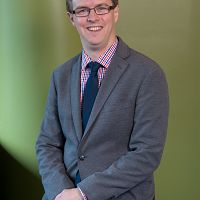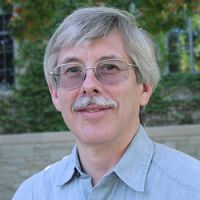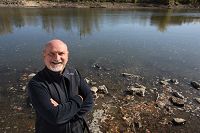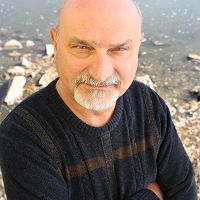IML-CZO Investigator Profiles: Marian Muste (University of Iowa)
During his first two years in the United States, IML-CZO investigator Dr. Marian Muste experienced two events that would become major news stories not just in Iowa but across the country.
Just months after Dr. Muste arrived in Iowa City, a recently graduated doctoral student went on a shooting rampage on the University of Iowa campus after he was denied a prestigious dissertation award. The attack was predominately aimed at faculty in the physics and astronomy department and left six dead including the gunman.
Then during the final semester of his coursework for his master of science in civil and environmental engineering, Dr. Muste observed what was perhaps the worst natural disasters in the state’s history when the Great Flood of 1993 devastated Central Iowa and other parts of the Midwest.
Despite his first two years in Iowa being bookended by tragedy and disaster, Dr. Muste stuck around the Hawkeye State. He completed his M.S. degree in 1993 and then a PhD in civil and environmental engineering in 1995. After graduation he was hired as a postdoctoral Research Scientist for IIHR-Hydroscience & Engineering at the UI before being promoted to a Research Engineer in 1998 which is the position that he still holds today.
Dr. Muste’s research focus is on river mechanics, sediment transport, and monitoring methods and instrumentation which are all particularly relevant to Iowa and other states in the IML region. Some of his most recent research focused on the Clear Creek Watershed which is one of three watersheds and river basins that part of the IML project.
“Last spring, we deployed in Clear Creek two pressure sensors to monitor the stage of the river. The probes were installed 600 feet apart, close to the stream bottom. The measurements were unattended, sampled every second for about three months,” said Dr. Muste. “By measuring simultaneously at two locations, we can determine the water free-surface slope and subsequently the actual flow magnitude in the stream. Such measurements are rarely made on a continuous basis despite that they allow us to accurately capture the dynamics of the storm wave propagation and hence to better understand flow and pollutants transport along the streams.”
Most of the instruments that Dr. Muste works with are “non-intrusive” which he says are able to measure different variables without necessarily being in the water. He compared these instruments to remote sensing done by satellites but in the case of the river observations, “the sensing is done at close range.” Radars, lidar, acoustics, and digital images are all technologies that allow to monitor rivers from a short distance.
These measurement techniques were useful for Dr. Muste and his research team when they studied the Iowa River after the historic flooding devastated much of Eastern Iowa in 2008. Using a grant awarded by the National Science Foundation, Dr. Muste and his team measured the velocity at the free surface over the entire river width to determine the discharge without the need to deploy any other equipment in the river. Measurements were made three or four times each day for two weeks using a regular video camera. Processing of the images with statistical algorithms allowed the researchers to determine the velocity across the river width and subsequently the discharge.
“The direct and continuous measurement of the discharge during flood events better captures the real movement of the flow in the river than the indirect methodologies currently used for monitoring flows,” Dr. Muste said. “The flow rising in the river has a different dynamics than on the falling flow. This can be seen when someone observes the Iowa River in Iowa City during an extreme flow, such as 1993 and 2008, when the Coralville dam’s capacity was exceeded and the flow spilled over. The flow hits its peak in a matter of few hours or days but takes over two weeks to recede.”
Dr. Muste is originally from Romania and he said he notices various similarities and differences between the United States and his home country. One example of similarities he pointed to was the intense alteration of the landscape caused by human activities such as farming. He also pointed out that many of the practices that occur on the land have a direct impact on nearby waterways.
“These alterations drastically accelerate water movement through the landscape leading to increased soil and in-stream erosion as well as to floods, which are becoming more frequent and more extreme,” he said.
One major difference between the United States and Romania that Dr. Muste pointed out was that much more funding and many more resources are dedicated to addressing environmental issues in the United States.
However, despite the challenges facing not just the United States but the entire world, Dr. Muste is optimistic the technology will continue to develop to allow researchers to be on the forefront of addressing these issues.
“The advances in instrumentation following the revolution in computer and communication technology open a new era for exploring processes in their natural environment. Many more discoveries will follow soon from the deployment of the new generation of smart instruments. I expect that following the computer revolution of the 1950s and the environmental sciences of the 1970s, this decade will be a revolution in sensing the environment, including the Critical Zone.”
By Nick Fetty (Journalism, University of Iowa)
This post is part of a series of articles featuring investigators involved in the IML-CZO project.
Related News

IML-CZO Investigator Profiles: Aaron Packman (Northwestern University)
08 Apr 2016 - Journalist Michael Pollan once said: “In one handful of soil there are more organisms than there are humans on earth and we are only beginning...

IML-CZO Investigator Profiles: Andrew Stumpf (Illinois State Geological Survey)
01 Apr 2016 - Between roughly 2 million years ago and 10,000 years ago, during the Pleistocene Epoch or “Ice Age,” massive glaciers swept across...

IML-CZO Investigator Profiles: Adam Ward (Indiana University)
18 Mar 2016 - Farming in the Midwest provides food and energy for the rest of the United States and even other parts of the world but some of the agricultural...

IML-CZO Investigator Profiles: Neal Blair (Northwestern University)
11 Mar 2016 - While urban and rural areas are seemingly polar opposites the two different areas depend greatly on one another, according to IML-CZO investigator...

IML-CZO Investigator Profiles: Art Bettis (University of Iowa)
26 Feb 2016 - Iowa poet laureate Mary Swander once said that the Hawkeye State has “the most altered landscape in the United States.” This...
Explore Further




